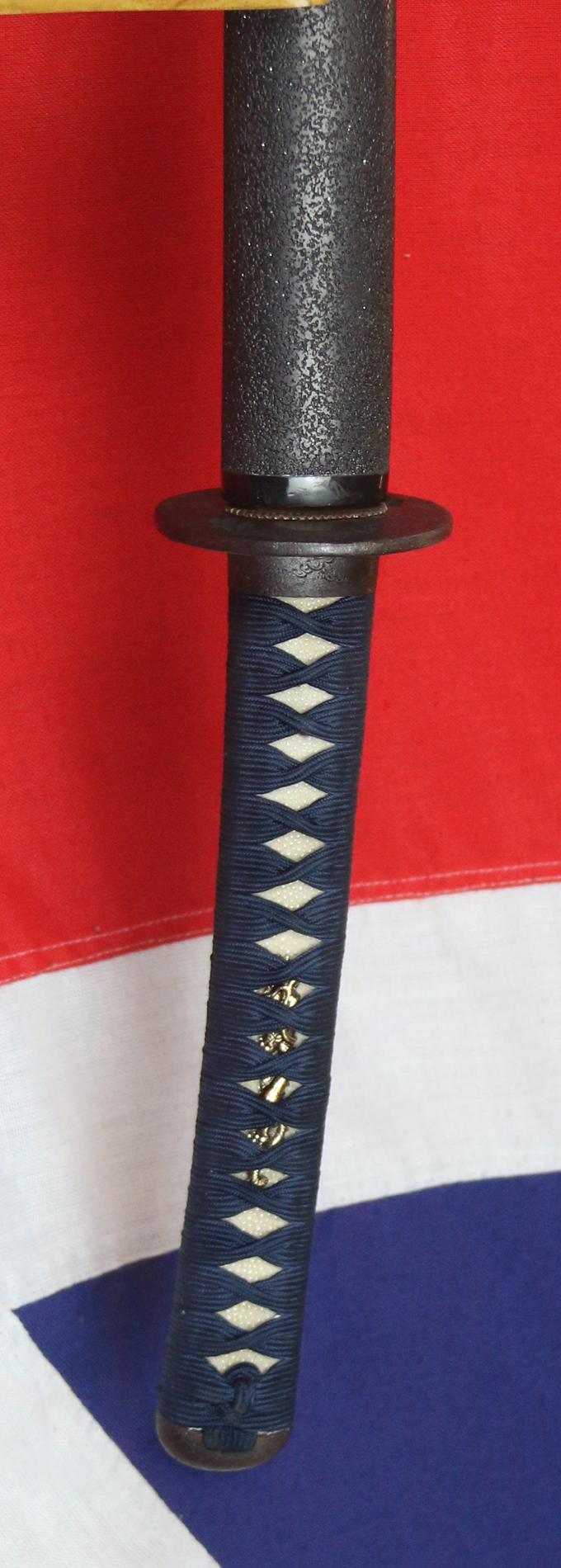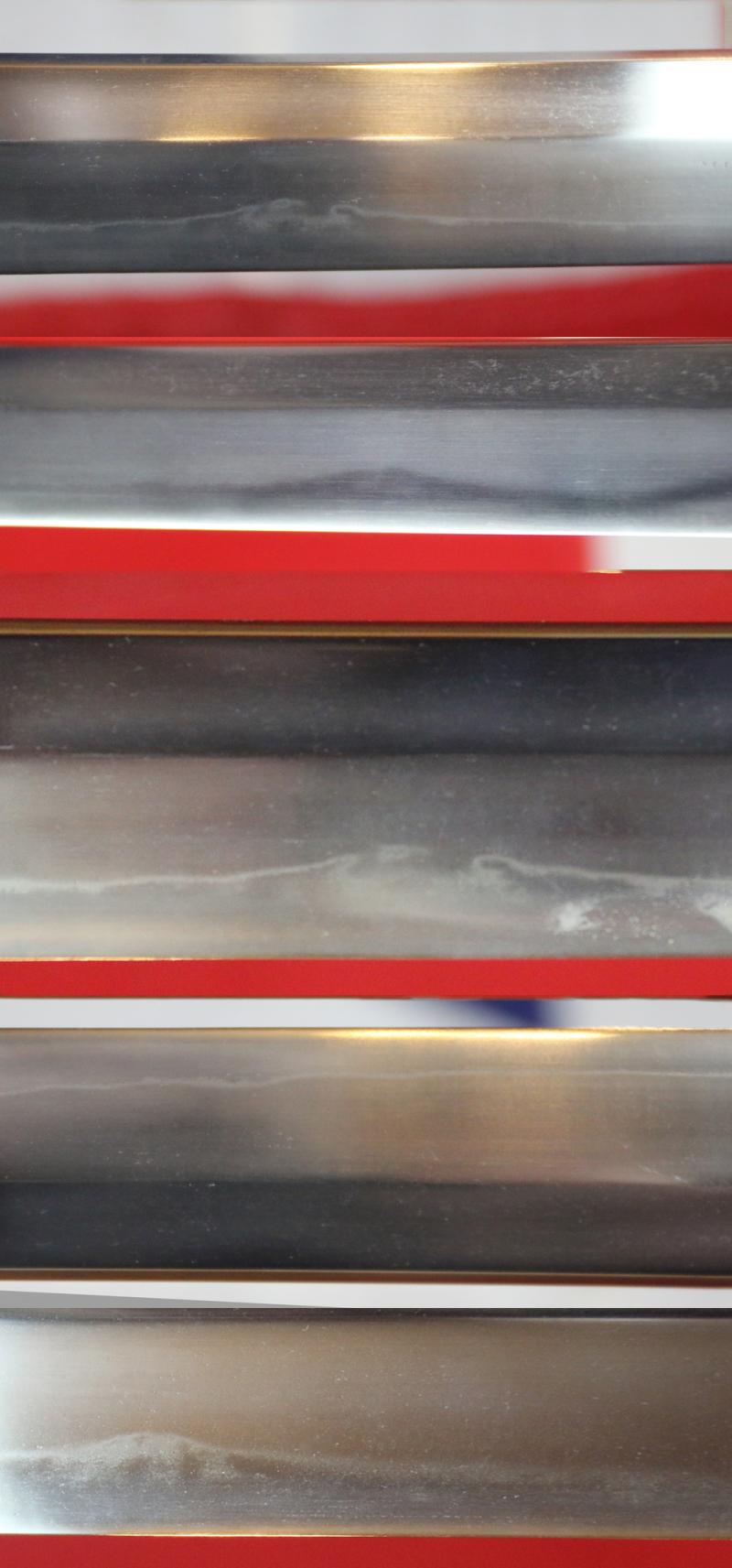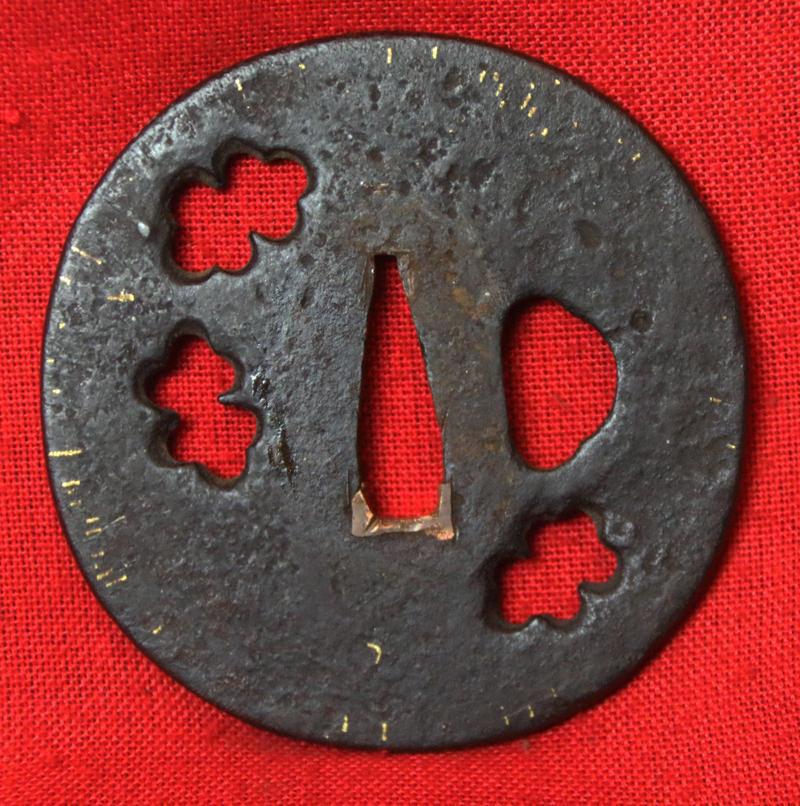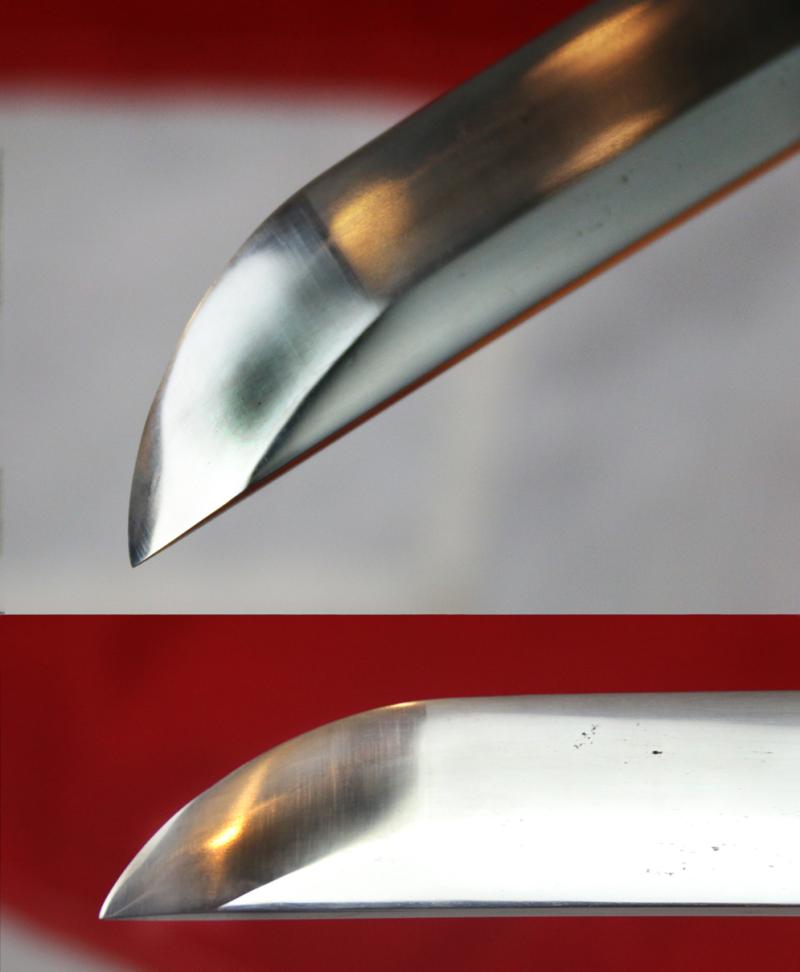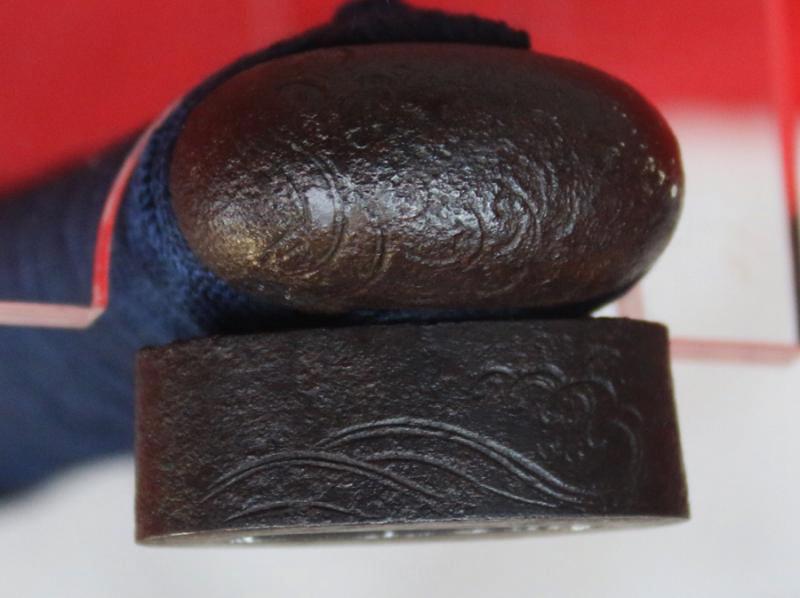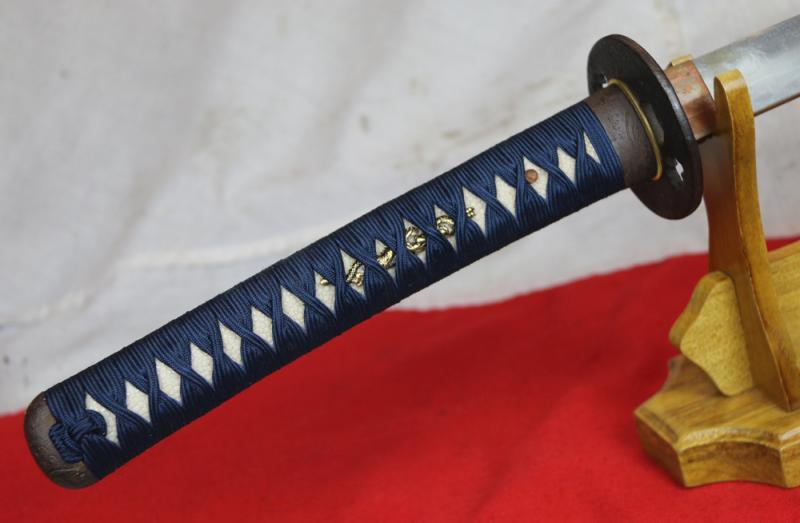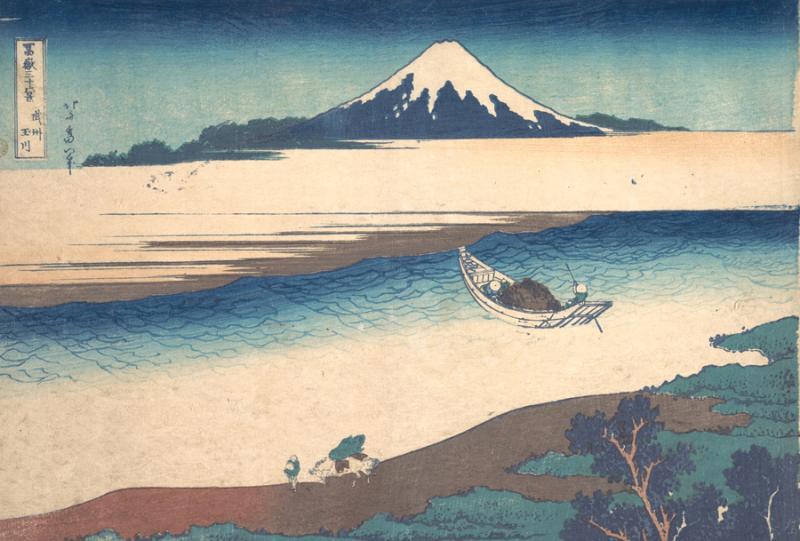A Superb Nobukuni 信国 Signed Mount Fuji Shinto Samurai Katana, Circa 1670, Signed on The Nakago Nobukuni Saku, With Mount Fuji Hamon and The Wave Fuchi Kashira.
This fabulous and unique 360 year old sword, by a high rated master swordsmith. A most substantial and incredibly impressive sword in super condition, with likely the most desirable and rarest form of hamon pattern.
It has a most rare, superb hamon that shows an horizon combined with Mount Fuji hamon, with the incredibly desirable hamon temper line that depicts seperate various views of the horizon with the snow topped Mount Fuji. The original Edo period Fuchigashira hilt mounts are carved iron, Higo style engraved with the representation of the crashing wave pattern that traditionally accompanies Mount Fuji, as can be seen the the world famous painting by Hokusai, 'The Wave' with Mount Fuji in the background.
The pierced early Edo iron tsuba is further complimentary with pierced clouds. Fully restored blue silk tsukaito binding, and the whole of the swords mounts have been cleaned and conserved to as good as new, with gilt dragon menuki beneath the silk ito.
In the most ancient swords, all hamon were of the straight-edge variety. Irregular patterns started to emerge around the 1300s, with famous smiths such as Kunimitsu, Muramasa, and Masamune, among many others. By the 1600--1700s, hamons with various shapes in them became very desirable, such as trees, flowers, clovers, pillboxes, and many others. Common themes included juka choji (multiple, overlapping clovers), kikusui (chrysanthemums floating on a stream), Yoshino (cherry blossoms on the Yoshino River), or Tatsuta (maple leaves on the Tatsuta River), and one of the most desirable of all, just as this sword has, was the design Fujimi Saigyo (Priest Saigyo viewing Mount Fuji)
Mount Fuji is a composite volcano, capped with snow, growing larger as layer upon layer of lava and ash built up on its slopes. Like its geologic history, Mount Fuji’s sacred history has also developed over time as different religions, beliefs and myths have added new layers. Since ancient times, the mountains of Japan have been revered as sacred places, giving rise to a tradition of beliefs and rituals that scholars call sangaku shinko, meaning “mountain creed.” When Shinto, the native religion of Japan, emerged sometime before the sixth century A.D., it wove this mountain creed into a wider veneration of nature. According to Shinto belief, natural features such as trees, lakes, streams, rocks and mountains are the dwelling places of spirits called kami, which hold influence over human affairs and respond to human prayer and ritual. Kami are believed to be concentrated in mountain areas, and shrines have been erected to mark sacred spots. The introduction of Buddhism from China in the sixth century further developed the practice of mountain worship as Buddhists, who viewed mountain climbing as a metaphor for the spiritual ascent to enlightenment, adopted Shinto sacred mountains as pilgrimage destinations. In the ninth century, a religious sect called Shugendo arose that based its doctrine and practice on mountain climbing itself, believing that practitioners could commune with deities on mountain summits and thereby obtain supernatural powers.
The name “Fuji” most likely came from an indigenous Ainu word meaning “deity of fire”—not surprising for a volcano that erupted often. In about 800 A.D., a shrine was built near the base of the mountain with the hope of placating the god that caused the volcano’s eruptions. Fuji later became regarded as the dwelling of the Shinto goddess Konohana Sakuya Hime, “the Goddess of the Flowering Trees.” Today, she is still the principal deity of the sacred mountain, revered in Shinto shrines at Fuji’s base and summit, including the one originally built for the older fire god, and honored in a fire ceremony at the end of each year’s climbing season. Buddhists found in Fuji an inspiring symbol of meditation and called its summit zenjo, a Buddhist term describing a perfect meditative state. Buddhists also came to regard Fuji as the abode of the Buddha of All-Illuminating Wisdom. In the 14th century, Shugendo practitioners established the first climbing route to lead pilgrims to Fuji’s summit.
As once told to us by an esteemed regular visitor to us here in our gallery, and the same words that are repeated in his book;
“In these textures lies an extraordinary and unique feature of the sword - the steel itself possesses an intrinsic beauty. The Japanese sword has been appreciated as an art object since its perfection some time during the tenth century AD. Fine swords have been more highly prized than lands or riches, those of superior quality being handed down from generation to generation. In fact, many well-documented swords, whose blades are signed by their makers, survive from nearly a thousand years ago. Recognizable features of the blades of hundreds of schools of sword-making have been punctiliously recorded, and the study of the sword is a guide to the flow of Japanese history.”
Victor Harris
Curator, Assistant Keeper and then Keeper (1998-2003) of the Department of Japanese Antiquities at the British Museum. He studied from 1968-71 under Sato Kenzan, Tokyo National Museum and Society for the Preservation of Japanese Swords
A most substantial blade, in nice condition for its age {of around 360 years} 28.25 inches long, from tsuba to tip overall 41 inches long including saya.
Code: 24955
8550.00 GBP



